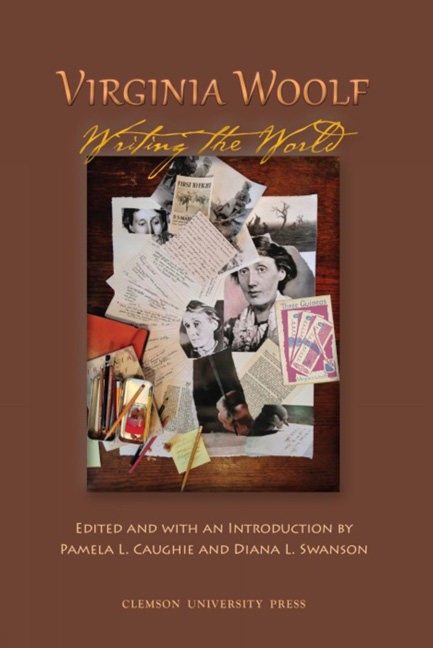Book contents
- Frontmatter
- Table of Contents
- Introduction
- Acknowledgmen
- Abbreviation
- WAR AND PEACE
- Roundtable: Woolf and Violence
- Intersections: Surveillance, Propaganda, and Just War
- Modernism and Memorials: Virginia Woolf and Christopher Isherwood
- Taking Up Her Pen for World Peace: Virginia Woolf, Feminist Pacifist. Or Not?
- The Sex War and the Great War: Woolf's Late Victorian Inheritance in Three Guineas
- Sky Haunting: The British Motor-Car Industry and the World Wars
- The 1914 “Expurgated Chunk”: The Great War in and out of The Years
- “beauty, simplicity and peace”: Faithful Pacifism, Activist Writing, and The Years
- Virginia Woolf, Katharine Burdekin, and Britain's Cosmopolitan Musical Culture
- Death in the Air: Virginia Woolf and Sylvia Townsend Warner in World War II
- WORLD WRITER(S)
- ANIMAL AND NATURAL WORLD
- WRITING AND WORLDMAKING
- Notes on Contributors
- Conference Program
- Appendix: Virginia Woolf Conference Exhibit Items, Newberry Library
“beauty, simplicity and peace”: Faithful Pacifism, Activist Writing, and The Years
from WAR AND PEACE
- Frontmatter
- Table of Contents
- Introduction
- Acknowledgmen
- Abbreviation
- WAR AND PEACE
- Roundtable: Woolf and Violence
- Intersections: Surveillance, Propaganda, and Just War
- Modernism and Memorials: Virginia Woolf and Christopher Isherwood
- Taking Up Her Pen for World Peace: Virginia Woolf, Feminist Pacifist. Or Not?
- The Sex War and the Great War: Woolf's Late Victorian Inheritance in Three Guineas
- Sky Haunting: The British Motor-Car Industry and the World Wars
- The 1914 “Expurgated Chunk”: The Great War in and out of The Years
- “beauty, simplicity and peace”: Faithful Pacifism, Activist Writing, and The Years
- Virginia Woolf, Katharine Burdekin, and Britain's Cosmopolitan Musical Culture
- Death in the Air: Virginia Woolf and Sylvia Townsend Warner in World War II
- WORLD WRITER(S)
- ANIMAL AND NATURAL WORLD
- WRITING AND WORLDMAKING
- Notes on Contributors
- Conference Program
- Appendix: Virginia Woolf Conference Exhibit Items, Newberry Library
Summary
In the constellation of values central to Virginia Woolf's ethical belief, pacifism remains one of the most controversial. Though it is fairly easy to celebrate her uncompromising opposition to the First World War or her youthful dabbling in political performance art during the Dreadnought Hoax or to sympathize with her devastation at losing her nephew Julian in the Spanish Civil War, these highlights of her pacifist stance can be overshadowed by her persistent pacifism at the end of her life.
Critical biographers have often portrayed these years as ones of tragic failure. Herbert Marder describes Woolf's perspective in 1940 as such: “if hearty patriotism was suspect, pacifism no longer served her either, and she had nothing to put in its place” (296). Even more pithily, Alex Zwerdling entitled the penultimate chapter of Virginia Woolf and the Real World “ Pacifism Without Hope.” There is all too often an uneasiness with Woolf's later pacifism which emerges in descriptions like Zwerdling's: “To [Woolf], nonviolence was an article of faith rather than a discretionary tactic—the closest thing to a religion her secular skepticism permitted” (274). For Zwerdling, it seems, the only way to explain Woolf's lack of realism, her clinging to a belief in spite of evidence, is to regard her pacifist convictions as religious.
It was not uncommon among Woolf's contemporaries to follow this line of thought and regard pacifism as essentially religious—either as a faith in its own right or as a political value that fundamentally arises from religion. One of the largest peace organizations of the 1930s was the Peace Pledge Union, a secular group founded by the charismatic Anglican Canon Dick Sheppard, whose personal religious beliefs motivated his peace activism even as he attempted to preserve his organization's secularity. Sheppard's Christian pacifist views were espoused by other PPU members, like Max Plowman who even off ered a thoroughgoing defense of pacifist convictions as a religion in his book The Faith Called Pacifism (1936).
But these religiously inclined peace activists adopt a position markedly diff erent from Woolf's own.
- Type
- Chapter
- Information
- Virginia Woolf: Writing the World , pp. 63 - 68Publisher: Liverpool University PressPrint publication year: 2015



